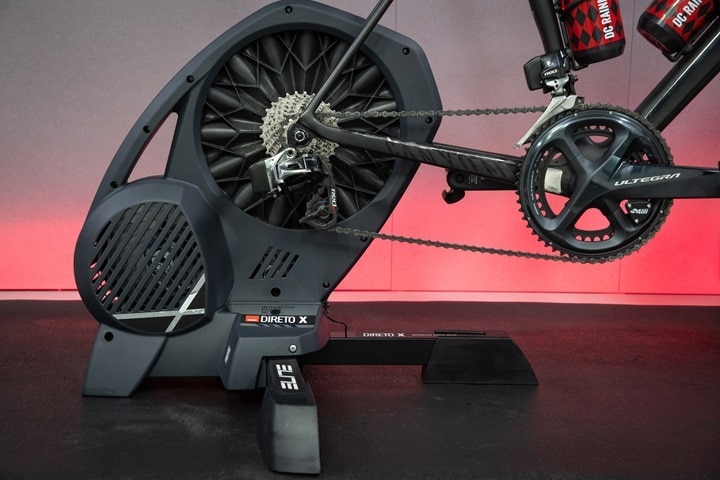
While Eurobike doesn’t officially start for another 15 hours, Elite is joining Saris in getting a jumpstart on things, this time on Eurobike Eve. Elite has just announced three new products – the Elite Direto X (this post), the Elite Steering Thingy (post on that coming tomorrow morning at show open), and the Elite Tuo wheel on trainer (also more on that tomorrow). As the title indicates I’ll be focused on their updated Direto series trainer for this post, which I have had for quite some time.
The Direto X takes the existing (and super popular) trainer and gives it a modest spec bump. Essentially it makes it compete more strongly in the mid-upper range of trainers against things like the Wahoo KICKR CORE. They’ve increased the incline simulation to 18% (from 14%), added longer rear derailleur cage support, and increased the accuracy of the onboard power meter to +/- 1.5% (from 2%), all while also making it a bit quieter. Minor changes for sure, but that’s often how Eurobike goes – evolutionary updates rather than revolutionary.
In any case, I dig into all the changes – including the accuracy shifts in this full in-depth review. As I said, I’ve had a media loaner for a while, and that will head back to them once I’ve wrapped up with it here soon. If you find the review useful you can hit up the links at the bottom to help support the blog.
With that – let’s dig into it!
What’s in the box:
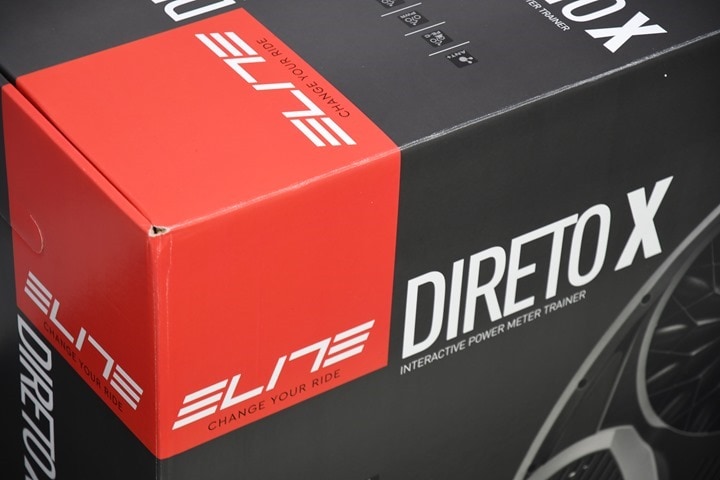
Perhaps the biggest thing they’ve changed physically is the box and the name – it’s now clear this is a Direto X. Previously with the Direto there were technically two iterations. The first year (2017) there was just the Direto. But then the second year (last summer), they quietly rolled out a near identical version called the Direto 2018, which hardware-wise was the same, but did include an extra riser block. They also increased the official accuracy specs from +/- 2.5% down to +/- 2.0%. This year with the Direto X it’s down to +/- 1.5%.
In any case – the box:

Once you remove all the cardboard you’ll have yourself a small pile of parts. More specifically: Three legs, a trainer, a front wheel block, and a power adapter. Also, a small baggy of paper and metal bits.
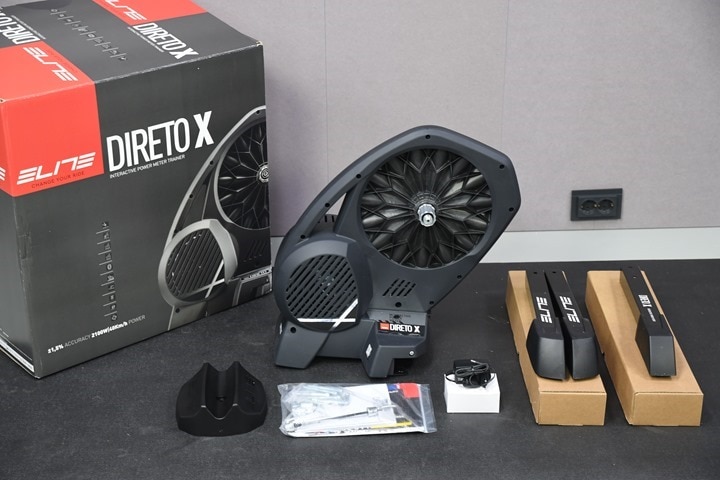
Here’s a closer look at all those bits. Starting with the trainer itself. It doesn’t include a cassette, a somewhat curious move since the less expensive Elite Suito ($799) does. Though, that trainer lacks the power of the Direto X, and doesn’t include a power meter.
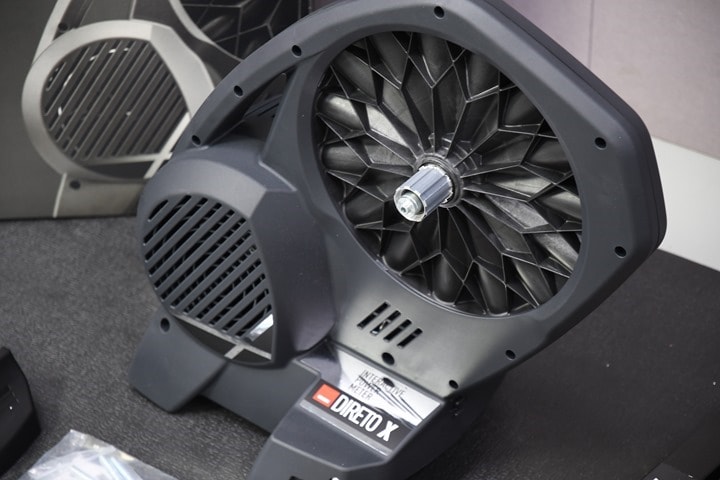
Then there’s the three legs. The front one sticks out permanently, whereas the two side legs are able to fold up to reduce the footprint. You’ll be attaching these in the next section.
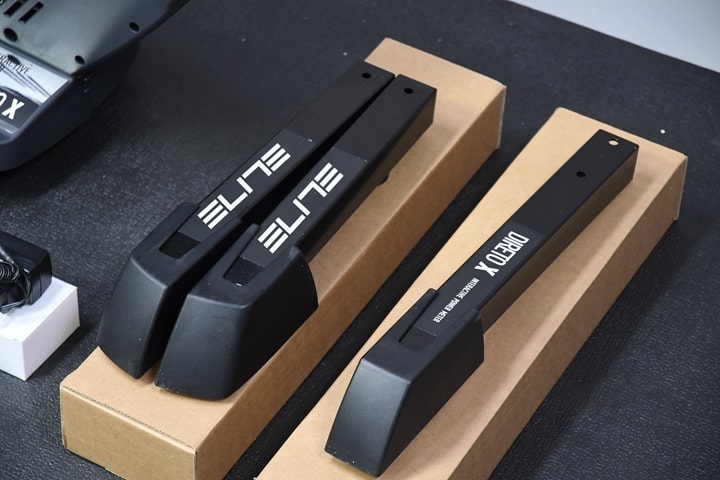
There’s the power supply, which…well…supplies power.
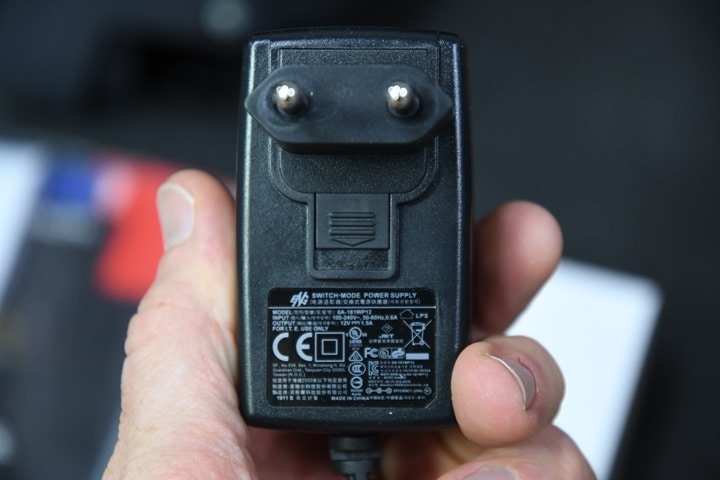
And there’s also a plastic baggie of parts:
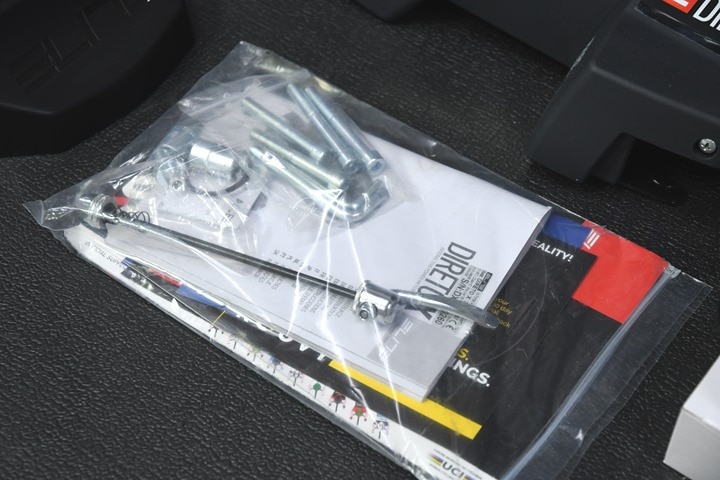
Inside this grab bag you’ll find:
A) Screws for the legs
B) Thru-axle adapters (130 & 135 x 5mm, 142 x 12mm)
C) A quick-release skewer
D) A boatload of papers
Here’s a closer look at that boatload of papers:
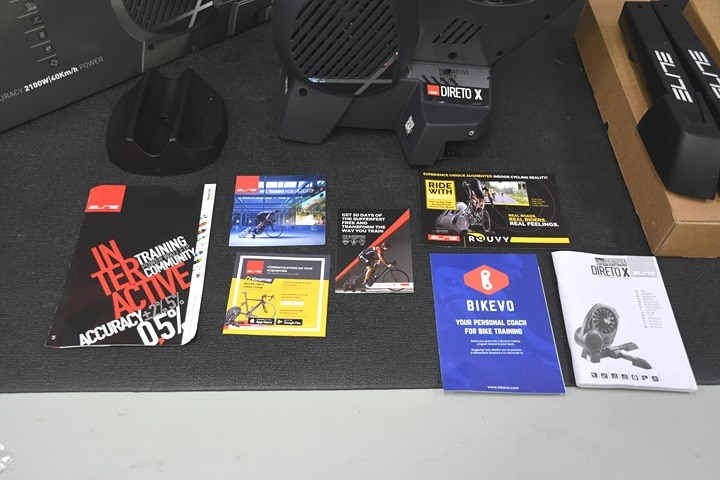
And finally, we’ve got the front wheel block:
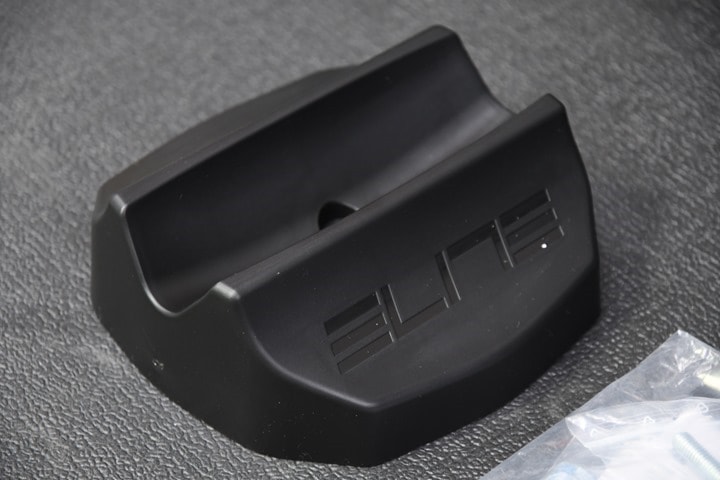
The wheel block is simply to keep your front wheel at roughly the correct height since the trainer increases the back height of the bike slightly. Also, some people (mainly, myself) like the fact that it keeps the front wheel from rotating around willy-nilly.
With that, let’s get this thing all put together.
The Basics & Setup:
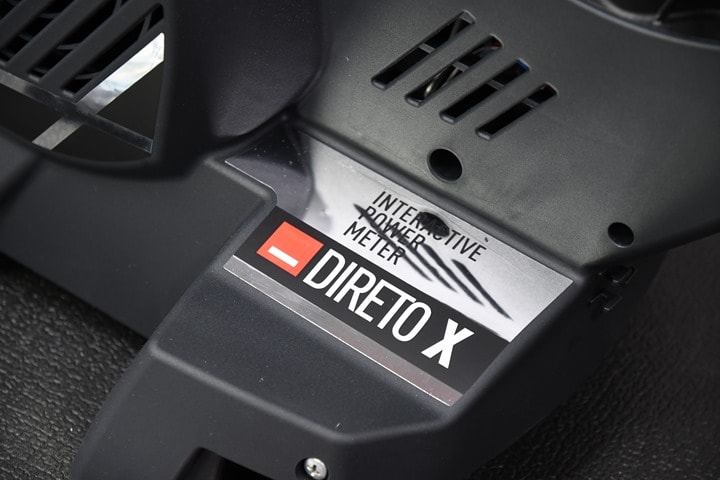
First up on the assembly front is adding ourselves a cassette. Unlike the Suito trainer, this one doesn’t come with one, so you’ll need to get your own.
I typically buy Shimano Ultegra cassettes for my trainers (mostly for sound-testing consistency across videos), but I’ve also done a few SRAM ones and whatever else happens to be on sale from the bike shop. It generally doesn’t matter, except sometimes you’ll find some of the lower end cassettes (like a Shimano 105) don’t quite sound as quiet as mid to higher-end ones.
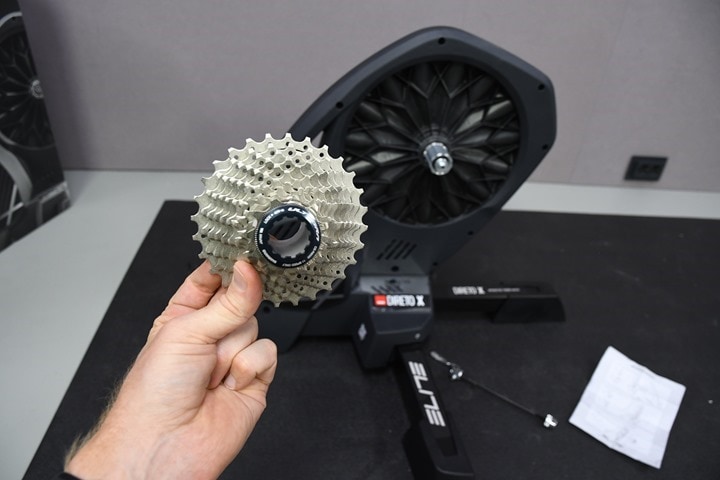
In any case, with a cassette, you’ll need two tools. A lockring tool (or lockring + a wrench, in my case), and a chain whip. In this case, you need the chainwhip since you can’t get a good grasp on the flywheel.
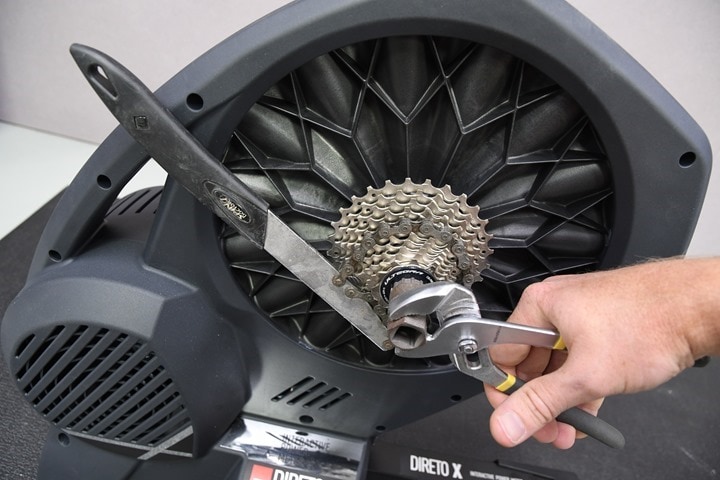
After the cassette is installed, go ahead and plop in the little skewer/axle adapters on both sides, and then stick on your quick release skewer (if not a thru-axle bike).
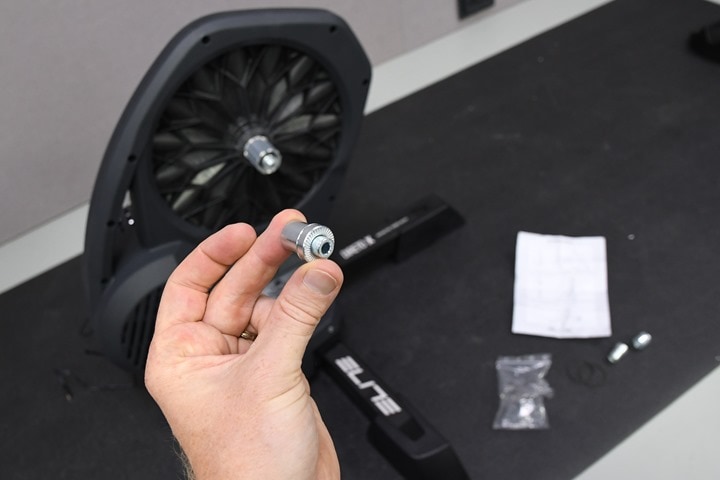
Then simply plug it in, and you’re good to go. The power adapter/cord is 120/240v, so you can use it anywhere in the world if you happen to travel with it. It has a little triple-catch system to prevent you from ripping it out of the trainer. Though, I think this basically just means you’ll take your entire bike with it instead if you trip over the cable. Or decapitate the cord. Not sure, not gonna try it.
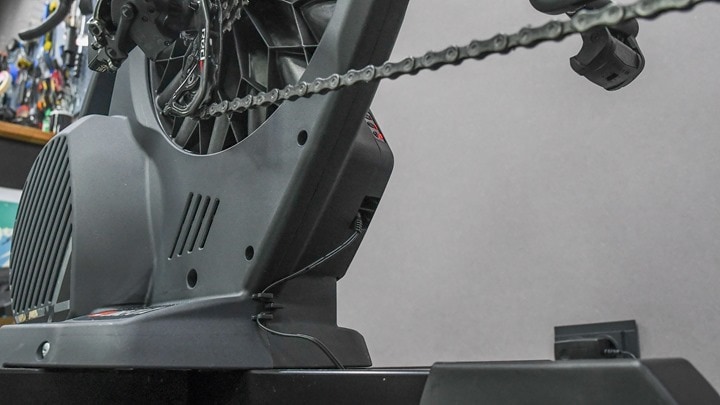
You’ll notice it’s got status lights down below; these indicate power as well as ANT+ & Bluetooth Smart communications and control.
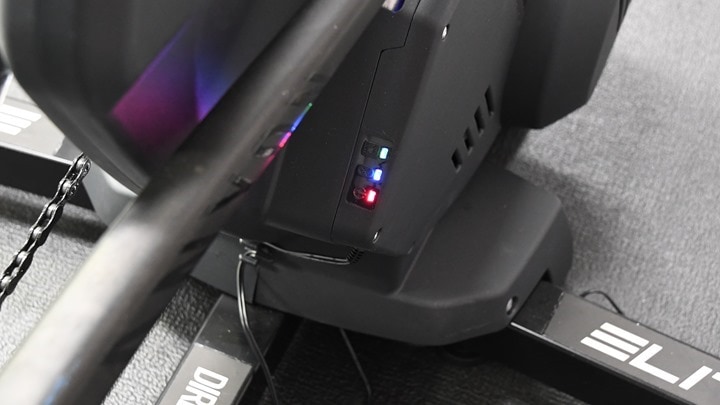
After you’ve mounted your bike, you can also slide that front wheel-block under there as well.
With that, we’re ready to roll. Now, we’ll get to app compatibility in a moment, but first let’s start with the road feel. Like I always say – for me personally, it’s hard to separate the fact that I’m riding indoors from outdoors. It’s still a trainer, and I’m still looking at a wall in front of me. My brain can only turn off so much of that. Still, much of the road-like feel is driven by the flywheel, and be it physical or virtual, flywheel sizes tend to be measured in weight. This impacts inertia and how it feels – primarily when you accelerate or otherwise change acceleration (such as briefly coasting).
All that prefacing done, I’d say this is slightly better than the Direto 2018, but still not quite to the same level as the equally priced Wahoo KICKR CORE, which has a far greater sized flywheel and better inertia. Remember that the KICKR CORE is basically just the KICKR 2017 with new legs. So, everyone was pretty darn happy with the KICKR 2017 from a road-feel/etc standpoint.
There’s nothing ‘wrong’ with the Direto X’s flywheel, it’s just not designed as a high-end trainer from a road-feel standpoint. And, unlike the KICKR CORE, Elite didn’t have the boatloads of various manufacturing issues (which, to be fair, seem to be behind us these days).
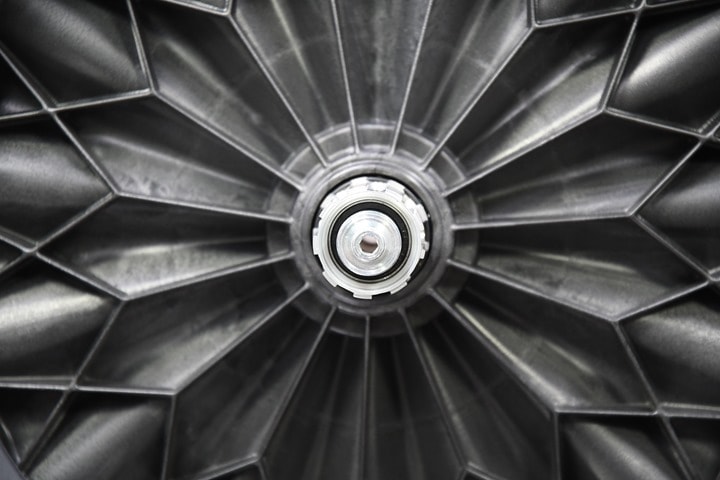
Now given the Direto X is a smart trainer, it’ll change resistance automatically in a few different ways, primarily driven by different applications/methods. But most of this all boils down to two core methods:
ERG Mode: Setting a specific power level – i.e., 215w. In this mode, no matter what gearing you use, the trainer will simply stay at 215w (or whatever you set it to).
Simulation Mode: Simulating a specific outdoor grade – i.e., 7% incline. In this mode, it’s just like outdoors in that you can change your gearing to make it easier or harder. Wattage is not hard-set, only incline levels.
In the case of simulation (aka slope) mode, the Direto X can simulate from 0% to 18% incline – which is above the competitors in this price point. The Wahoo KICKR CORE simulates up to 16%, while the Tacx Flux 2 matches that as well at 16%.
The second mode the trainer has is ERG mode. In that case, the company claims up to 2,100w of resistance at 40KPH. Although, realistically, you don’t care about that. I can only barely (maybe) break 1,000w for a second or two, and even most front of the non-pro pack cyclists aren’t going to top 1,800w. The pros would only be just a bit beyond that. Said differently: Peak numbers don’t matter. Instead, what matters is actually a harder metric to make clear – which is the ability to simulate high grades and lower speeds (especially if you’re a heavier cyclist).
One core test I do with all trainers though is responsiveness: How quickly does it respond to ERG mode changes? I typically do that with my 30×30 test via TrainerRoad, though it doesn’t really matter what method you use as long as you’re looking at big shifts in wattage:

In this case, the Direto X initially responded quickly, but couldn’t stabilize very well to the big shifts (this was done in the small ring in front, which should increase stability of situations like this). But it wobbled too much, for 30×30 workouts, this wouldn’t be an acceptable trainer for me, since I’m constantly chasing watts that are significantly above/below the target threshold. This means I’ve effectively missed the point of this workout because it was either far too difficult, or far too easy. I highlighted above a few examples, though it realistically happens on most intervals.
In looking into things, Elite says that they’re going to dig into the firmware and they’re suspicions that the newer stronger magnets may be overpowering in certain scenarios, causing the overshoot. And if I look back at my initial Elite Direto ERG mode responsiveness, it was something that it also struggled with a little bit.
App Compatibility:
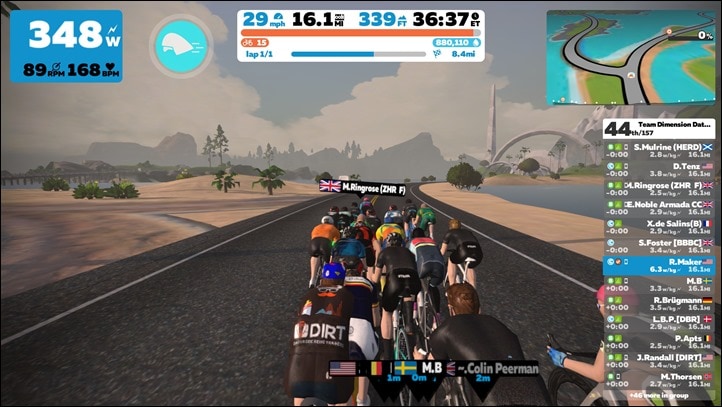
The Direto X follows the same app compatibility standards as previous Elite products, and essentially follows the industry norms as you’d expect from a high-end trainer. As you probably know, apps like Zwift, TrainerRoad, SufferFest, Rouvy, Kinomap and many more all support most of these industry standards, making it easy to use whatever app you’d like. If trainers or apps don’t support these standards, then it makes it far more difficult for you as the end user.
Thankfully, that’s not the case here. The Direto X transmits data on both ANT+ & Bluetooth Smart, as well as allowing interactive resistance control across both ANT+ & Bluetooth Smart. By applying resistance control apps can simulate climbs as well as set specific wattage targets.
The unit supports the following protocols and transmission standards:
ANT+ FE-C Control: This is for controlling the trainer via ANT+ from apps and head units (with cadence/power data). Read tons about it here.
ANT+ Power Meter Profile: This broadcasts as a standard ANT+ power meter, with cadence data
ANT+ Speed/Cadence Profile: This broadcasts your speed and cadence as a standard ANT+ Speed/Cadence combo sensor
Bluetooth Smart Power Meter Profile: This broadcasts as a standard BLE power meter, with cadence data
Bluetooth Smart Speed/Cadence Profile: This broadcasts your speed and cadence as a standard BLE combo Speed/Cadence sensor
Between all these standards you can basically connect to anything and everything you’d ever want to. Be it a bike computer or watch, or an app – it’ll be supported. In fact, Elite’s really been one of the leaders in supporting the various standards – including most recently FTMS.
In the above, you’ll note there’s cadence data baked into the various streams. That’s handy if you’re connecting to Zwift on an Apple TV, due to Apple TV’s two concurrent Bluetooth Smart sensor limitation (plus the Apple TV remote). This means you can pair the trainer and get power/cadence/control, while also pairing up a heart rate strap.
For me, in my testing, I used Zwift and TrainerRoad as my two main apps (which are the two main apps I use personally). In the case of Zwift, I used it in regular riding mode (non-workout mode, aka SIM mode), whereas in the case of TrainerRoad I used it in a structured workout mode (ERG mode). I dig into the nuances of these both within the power accuracy section.
Starting with Zwift, you can see the Direto X listed as not just a controllable trainer, but also within the regular power meter and cadence section. You’ll want to pair it up as a controllable trainer (which will also pair it as a power meter):
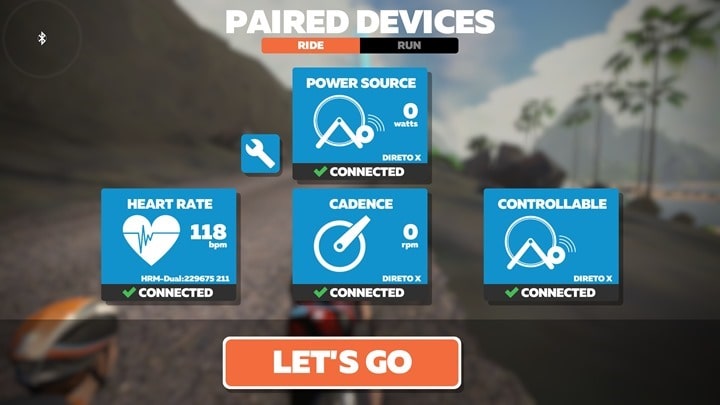
And then you can manually select the cadence signal. I’ve never understood why Zwift isn’t smart enough to simply look for the same named cadence one too, given it does exactly that when looking at the generic power source. Things I’ll have to ask them at some point.
You’ll see the trainer enumerated in a fairly similar manner on TrainerRoad as well:
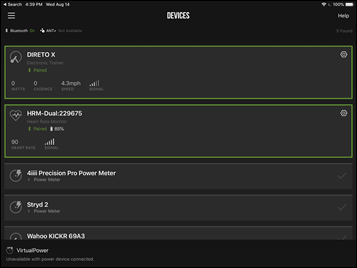
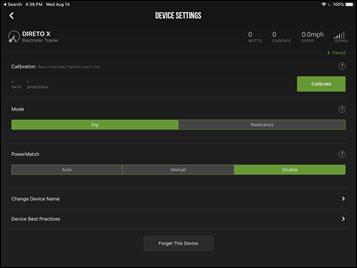
Also, TrainerRoad’s tips page on using smart trainers in ERG mode:
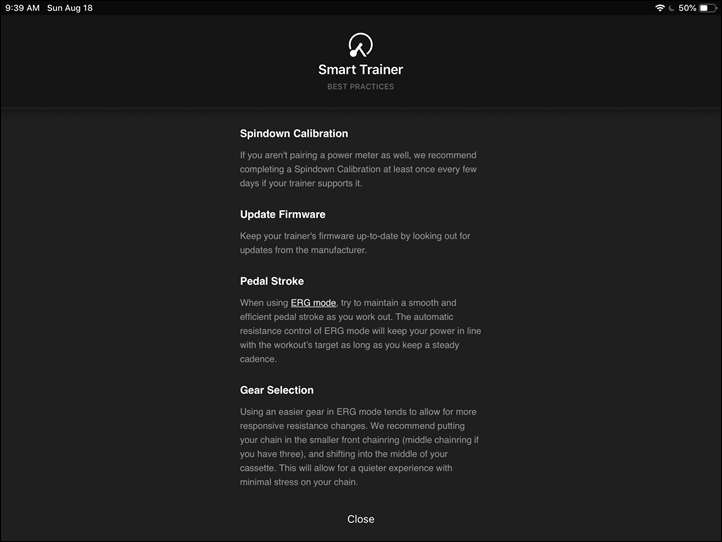
I’d *strongly* recommend you either read that page, or just simply do two things:
A) Calibrate the Direto X: I found it did make a significant difference to do the roll-down, it only takes a few seconds
B) Ensure you’re using the small ring up front: This is for ERG mode specifically, shift into the small ring to get better control
As far as calibration goes, you can complete it easily from most apps – including TrainerRoad and Zwift. You’ll see either a calibration prompt in the app (like TrainerRoad), or a small wrench or such in the settings (like Zwift). For example, here it is doing the spin-down within TrainerRoad:
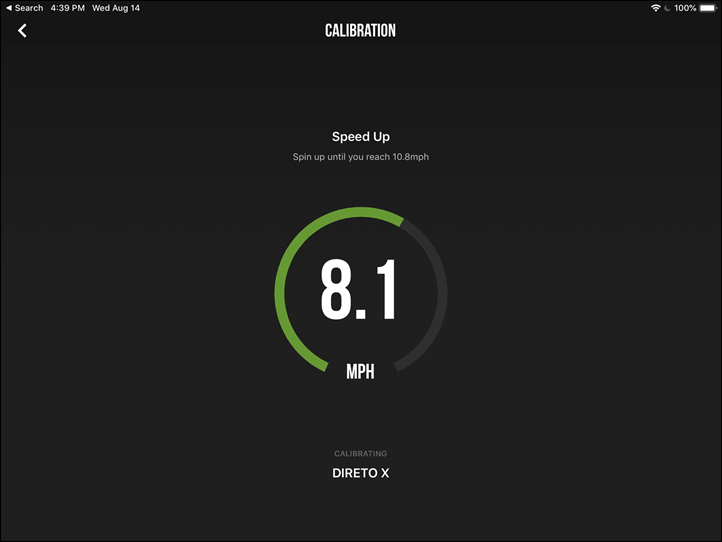
It’s super easy to do, you just pedal a bit fast for a moment until it reaches a given threshold speed, and then you stop pedaling. It’s going to measure how long it takes to coast to a stop. Super easy.
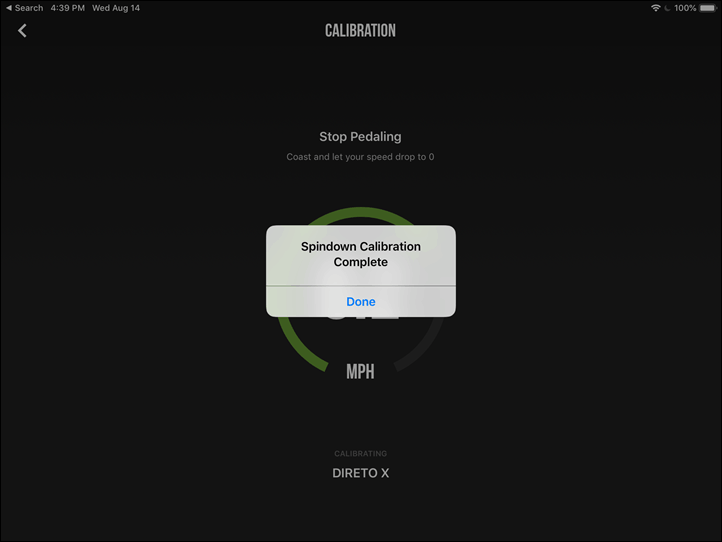
In general you should calibrate every once in a while (perhaps every few weeks), or anytime you’ve moved the trainer some distance (like to a new home/etc…). Additionally, you should calibrate if you’ve had a major temp swing (such as if it lives in your garage and now the sweat puddle on the floor is frozen). In my testing – I found it legit did make a difference in temp shifts (about 2-5% in fact). In fact I threw out a few tests from this review cycle where I had used it outdoors on a nice summer day but didn’t calibrate it, that data was inaccurate as the temp has shifted considerably from the indoor tests.
Again, you can also do these calibrations within Zwift or most any other app. Easy stuff.
Finally, Elite does have their own app that you can use for a handful of functions, but I had no use for it here at any point in the testing cycle. Apparently a new app is coming this fall that will make firmware updates easier, as right now it’s a bit of a mess. Once that app is out, I’ll look to add some notes to this review about it.
Power Accuracy Analysis:

As usual, I put the trainer up against a number of power meters to see how well it handled everything from resistance control accuracy, to speed of change, to any other weird quirks along the way.
In my case I used one primary bike setup as follows in two configurations:
Canyon Bike Setup #1: Garmin Vector 3 pedals (dual-sided), 4iiii Precision Podium (dual-sided)
Canyon Bike Setup #2: Garmin Vector 3 pedals (dual-sided), Quarq DZero
This is all in addition to the trainer itself. Note that because you remove the rear wheel I can’t use something like a PowerTap hub to compare as well (which I would use in power meter testing normally).
In my case, I was looking to see how it reacted in two core apps: Zwift and TrainerRoad (Bluetooth Smart on Apple TV and iPad), but I also did some work on Rouvy in beta on Apple TV – so there’s that for you. The actual apps don’t typically much matter, but rather the use cases are different. In Zwift you get variability by having the road incline change and by being able to instantly sprint. This reaction time and accuracy are both tested here. Whereas in TrainerRoad I’m looking at its ability to hold a specific wattage very precisely, and to then change wattages instantly in a repeatable way. There’s no better test of that than 30×30 repeats (30-seconds at a high resistance, followed by 30-seconds at an easy resistance).
There’s two ways to look at this. First is how quickly it responds to the commands of the application. So for that, we need to actually look at the overlay from TrainerRoad showing when it sent the command followed by when the Direto X achieved that level. Here’s the levels being sent (the blue blocks)) by TrainerRoad (in this case via Bluetooth Smart on iPad) and how quickly the Direto X responded to it:
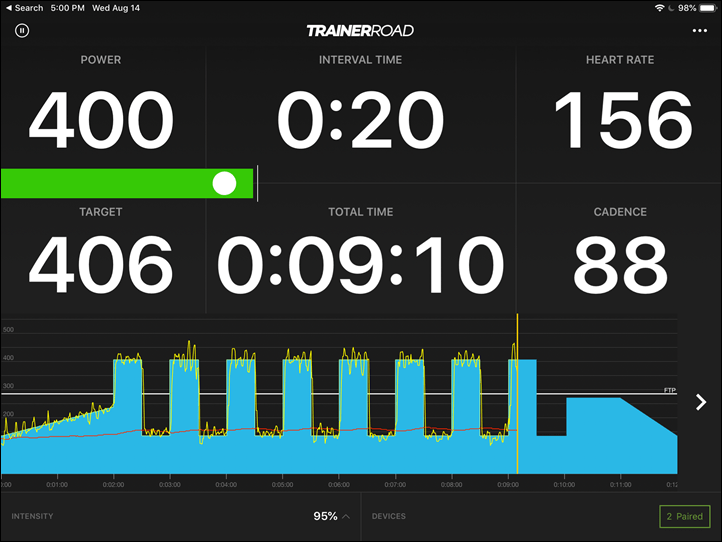
As we discussed earlier on in the overall basics section, the Direto X doesn’t respond super well to fast and significant shifts in ERG mode. It’s fine for more ‘normal’ ERG mode shifts (like say from 230w to 250w or to 275w). But the massive shifts in ERG mode from ~150w to ~402w were just too much for it and the stepper motor system, and it just kept on hunting for the power.
But, let’s set that aside for a second (the inability to quickly lock a given target power), and instead ask – was the power itself accurate? In other words, it may have been unstable, but was at least accurately unstable? And for that the answer is a very clear ‘Yes’. Here’s that data set:

You can see above that compared to the Garmin Vector 3 and 4iiii Precision power meters it’s almost always within a few watts. There’s a brief moment where you see the green line of Vector dip out, but that was just a general ANT+ interference thing for that head unit.
Here’s a closer look at a few of those intervals:

You can see that it’s within a few watts on all those intervals – super tight and good. Happy times there.
But what about the cadence channel? Well…yeah.

You can see there are some spikes there on the Direto X. They appear to be tied to coming off the interval, as I shift back from 400w down to 150w. Here, if I show you that chart again of the power below, you can see the two align to those points.

This isn’t ideal, and I’ve brought it up to Elite to investigate. Mind you, cadence on these units are ‘estimated’, and like with the recent Saris Hammer 3 (H3) trainer, there are sometimes a few gaps there.
In any case, let’s shift away from ERG mode. In general – accuracy of power is spot-on there, but accuracy of cadence isn’t amazing, but not horrible either. Kinda blah.
So, SIM mode – aka normal Zwift mode. On this course I used my new favorite testing ground of the Zwift Road to Titans route:

This route starts off on the flats, and then climbs up into Titans Grove for a slew of rollers before coming back down again. It’s amazing for testing trainers, responsiveness, and how they deal with quick shifts in gradient, pace, and power. It’s like this course was designed for punishing trainers. In any case, here’s that data set:

As you can see at a high level, pretty solid. But let’s zoom into three specific sections: The first sprint, the middle rollers, and then the last sprint. Here’s my first warm-up sprint (just a few minutes into the ride):

I’m not sure there’s really any question in the above graph. That’s astonishingly close for a sprint, no matter how you slice it. Very well done.
So, let’s move onto what is turning out to be the most tricky item for trainers this year: The rollers of the Titans Grove route. Again, this course has been slaughtering some trainers this year. But for the Direto, it actually handled it surprisingly well:

In terms of responsiveness during this section, it was pretty good. Perhaps in some cases a 1-1.5 second delay, but I’m not sure if I’d blame that as much on Elite as on the combination of the underlying way that apps send trainers gradient information such that by time that all happens, it may be slightly behind reality. Perhaps there’s more of an industry way to handle complex courses like this.
In any case, that final sprint. I’ve included a bunch of the flat-lands as well in here, just for fun. But you can see the sprint sticking out like a giant…monument…in the middle of it all.

Here I escalate quickly up to 900w (the graphs above are smoothed at 3-seconds, so it’s actually a bit higher), and the trainer and power meters stay locked on together. Speaking of which, no power matching was used in any of this. I’m not a fan of such things.
So, while the power accuracy was awesome on this route, what about cadence accuracy? Ask and you shall receive:

Basically flawless.
In other words, any of the cadence accuracy issues I saw appear to be limited to the ERG mode realm, rather than SIM mode. Note that Zwift can also use ERG mode (and does) for ‘Workout Mode’, so it’s not as if this is a Zwift versus TrainerRoad sorta thing. Just a case of which modes the trainer uses, and really more specifically, likely the huge jumps in power that my 30×30 workout is designed to stress.
So, overall from a power accuracy standpoint I really can’t find any faults at all in the Elite Direto X. Not saying there aren’t scenarios that someone may stumble into, but in my tests, they were good. From a cadence accuracy standpoint, it seems a bit more variable – but depends on the scenarios.
Finally note that I’ve shown the last two data sets I’ve done on this trainer. As I noted earlier in the review, I threw away a pile of data sets that didn’t match where I hadn’t done a calibration when I used the trainer outdoors. In those sets there was a clear offset in the data, but once I did the calibrations, things were happy panda from there on out.
(Note: All of the charts in these accuracy portions were created using the DCR Analyzer tool. It allows you to compare power meters/trainers, heart rate, cadence, speed/pace, GPS tracks and plenty more. You can use it as well for your own gadget comparisons, more details here.)
Trainer Comparisons:
I’ve added the Direto X into the product comparison database. This allows you to compare it against other trainers I’ve reviewed. For today I’ve compared it against the Tacx Flux 2, the Elite Direto (2018), the Wahoo KICKR CORE, and the new (CycleOps) Saris H3. Keep in mind Eurobike starts tomorrow and there could be additional trainers announced. However, by 9AM Germany time on Sept 4th, 2019 – we’ll know everything that’s planned for this year.
| Function/Feature | Elite Direto X | Elite Direto (2018) | Saris H3 | Tacx Flux 2 | Wahoo Fitness KICKR CORE |
|---|
| Copyright DC Rainmaker - Updated November 26th, 2024 @ 2:16 pm New Window |
| Price for trainer | $899 | $849 ($799 for 2017 models) | $1,099 | $899 | $499 |
| Trainer Type | Direct Drive (No Wheel) | Direct Drive (No Wheel) | Direct Drive (no wheel) | Direct Drive (no wheel) | Direct Drive (No Wheel) |
| Available today (for sale) | Yes | Yes | Yes | YEs | Yes |
| Availability regions | Global | Global | Global | Global | Global |
| Wired or Wireless data transmission/control | Wireless | Wireless | Wireless | Wireless | Wireless |
| Power cord required | Yes (no control w/o) | Yes (no control w/o) | Yes | Yes | Yes |
| Flywheel weight | 4.2KG/9.2LBS | 4.2KG/9.2LBS | 20lb/9kg | 7.6kg (simulated 32.1kg) | 12.0lbs/5.44kgs |
| Includes cassette | No | No | No | No | No |
Resistance | Elite Direto X | Elite Direto (2018) | Saris H3 | Tacx Flux 2 | Wahoo Fitness KICKR CORE | | Can electronically control resistance (i.e. 200w) | Yes | Yes | Yes | Yes | Yes |
| Includes motor to drive speed (simulate downhill) | No | No | No | No | No |
| Maximum wattage capability | 2,100w @ 40KPH / 3,250w @ 60KPH | 1,400w @ 40KPH / 2,200w @ 60KPH | 2,000w | 2,000w @ 40KPH | 1800w |
| Maximum simulated hill incline | 18% | 14% | 20% | 16% | 16% |
Features | Elite Direto X | Elite Direto (2018) | Saris H3 | Tacx Flux 2 | Wahoo Fitness KICKR CORE | | Ability to update unit firmware | Yes | Yes | Yes | Yes | Yes |
| Measures/Estimates Left/Right Power | 9EUR one-time fee | 9EUR one-time fee | No | No | No |
| Can directionally steer trainer (left/right) | With steering accessory & compatible app | No | No | No | No |
| Can simulate road patterns/shaking (i.e. cobblestones) | No | No | No | No | No |
Motion | Elite Direto X | Elite Direto (2018) | Saris H3 | Tacx Flux 2 | Wahoo Fitness KICKR CORE | | Whole-bike physical gradient simulation | No | No | No | No | With KICKR CLIMB accessory |
| Can rock/tilt side to side (significantly) | No | No | No | No | No |
Accuracy | Elite Direto X | Elite Direto (2018) | Saris H3 | Tacx Flux 2 | Wahoo Fitness KICKR CORE | | Includes temperature compensation | N/A | N/A | Yes | Yes | Yes |
| Support rolldown procedure (for wheel based) | Yes | Yes | Yes | Yes | Yes |
| Supported accuracy level | +/- 1.5% | +/- 2% (Sept 2018 models, +/- 2.5% for earlier models) | +/- 2% | +/-2.5% | +/- 2% |
Trainer Control | Elite Direto X | Elite Direto (2018) | Saris H3 | Tacx Flux 2 | Wahoo Fitness KICKR CORE | | Allows 3rd party trainer control | Yes | Yes | Yes | Yes | Yes |
| Supports ANT+ FE-C (Trainer Control Standard) | Yes | Yes | Yes | Yes | YEs |
| Supports Bluetooth Smart FTMS (Trainer Control Standard) | Yes | Yes | Yes | Yes | YEs |
| WiFi or Ethernet | | | | | No |
Data Broadcast | Elite Direto X | Elite Direto (2018) | Saris H3 | Tacx Flux 2 | Wahoo Fitness KICKR CORE | | Transmits power via ANT+ | Yes | Yes | Yes | Yes | Yes |
| Transmits power via Bluetooth Smart | Yes | Yes | Yes | Yes | Yes |
| Supports Multiple Concurrent Bluetooth connections | No, just one | No, just one | No, just one | No, just one | Yes, 3 Concurrent |
| Transmits cadence data | Yes | Yes | Yes | Yes | Yes |
| Bridging or re-transmission | | | No | | No |
Purchase | Elite Direto X | Elite Direto (2018) | Saris H3 | Tacx Flux 2 | Wahoo Fitness KICKR CORE | | Amazon | Link | Link | Link | Link | Link |
| Backcountry.com | | | Link | | Link |
| Competitive Cyclist | | | Link | Link | Link |
| REI | | | Link | Link | Link |
DCRainmaker | Elite Direto X | Elite Direto (2018) | Saris H3 | Tacx Flux 2 | Wahoo Fitness KICKR CORE | | Review Link | Link | Link | Link | Link | Link |
Don’t forget you can mix and match your own trainer product comparison tables using the database here.
Summary:
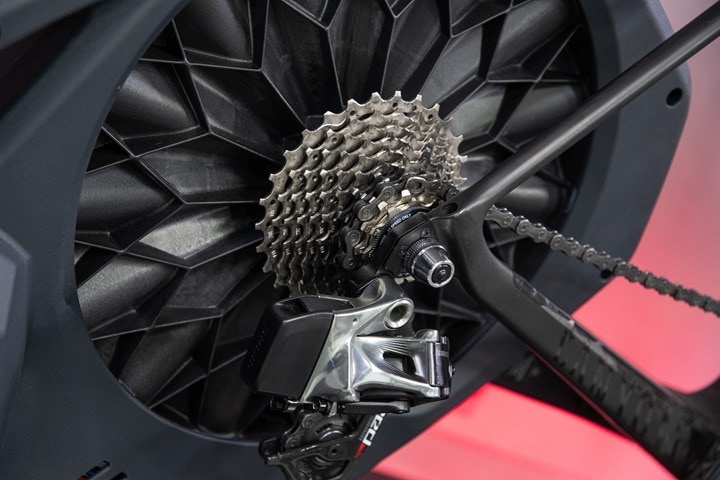
The Direto X builds upon the existing Elite Direto brand, with its increased incline simulation and increased accuracy claims. Additionally with the frame of the Direto X redesigned slightly it’ll accommodate the longer derailleur cage bike setups. Plus of course, it’s quieter than before – all pluses. I don’t think I can overstate the accuracy here. In many ways, the existing Elite Direto was probably already this accurate on paper, just not in marketing claims. However, the main difference here is the stronger magnets to give it more power for the climbs.
The challenge I think Elite has though is probably their own products. With the Elite Suito being $100 less (and including a cassette), it’s going to take a lot of wind out of the sails for many buyers. Now the Suito firmware isn’t yet to the level I want it to be in terms of accuracy, so that remains an outstanding item (trainers haven’t yet hit peoples’ hands, so the firmware is still being finalized). And the Suito doesn’t have a power meter inside it like the Direto X, though as I’ve said countless times before: Having a power meter inside a trainer is meaningless. What matters is whether the power is accurate. Neither the KICKR or Tacx NEO have power meters and are just fine accuracy-wise. Again – the end result matters here, not how companies achieve it.
The other challenge Elite has is ERG mode responsiveness. One of the things they improved in the Suito but not the Direto X is the faster ERG mode responsiveness – some 3x faster in fact. And it’s very likely that when all is said and done, the Suito will be a better ERG-mode trainer than that of the Direto X. Again, for less money. Of course, on the flip side – the Direto X is more powerful, though, I’d guess that 95% of people will never need that added power.
In any event, Elite’s offerings this year are largely within the ‘minor tweaks and better price points’ realm, and the Direto X seems to fit the first part of that bill. There’s no reason why every trainer company has to launch a major new trainer every year. Though, come to think of it – Elite’s launched two addition new trainers this year (Suito and as of today, Tuo), plus also a new steering accessory. So, maybe they’re innovating more than people are giving credit for. With that – thanks for reading!
Found This Post Useful? Support The Site!
Hopefully you found this review/post useful. At the end of the day, I’m an athlete just like you looking for the most detail possible on a new purchase – so my review is written from the standpoint of how I used the device. The reviews generally take a lot of hours to put together, so it’s a fair bit of work (and labor of love). As you probably noticed by looking below, I also take time to answer all the questions posted in the comments – and there’s quite a bit of detail in there as well.
If you're shopping for the Elite Direto X or any other accessory items, please consider using the affiliate links below! As an Amazon Associate I earn from qualifying purchases. It doesn’t cost you anything extra, but your purchases help support this website a lot.
Since the Elite Direto X is no longer sold, I recommend looking at
Elite Direto XR:
And finally, here’s a handy list of trainer accessories that most folks getting a smart trainer for the first time might not have already:
There's no better bang for your buck in getting Zwift (or FulGaz/etc) on your big screen TV than Apple TV - it's the primary way I Zwift.
This is a super basic trainer mat, which is exactly what you'll see me use. All it does is stop sweat for getting places it shouldn't (it also helps with vibrations too).
I use Apple TV for Zwift the vast majority of the time, but also just for watching YouTube/Netflix/etc on the trainer. The Apple TV remote sucks though. This $8 case fixes that, it's a silicone strap that makes it easy to grab, but also has a strap to easily place on the edge of your handlebars. Boom! Note: Not compatible with 2021 Apple TV Edition.
Here's the thing, some people like front wheel blocks, some don't. I'm one of the ones that do. I like my front wheel to stay put and not aimlessly wiggle around. For $8, this solves that problem. Note some trainers do come with them. Also note, I use a riser block with *every* trainer.
I've got three of these $12 fans floating around the DCR Cave, and I frequently use them on rides. They work just fine. Sure, they're not as powerful as a Wahoo Headwind, but I could literally buy 20 of them for the same price.
This desk is both a knock-off of the original KICKR Desk, but yet also better than it. First, it's got wheel locks (so the darn thing stays put), and second, it has two water bottle holders (also useful for putting other things like remotes). I've been using it as my main trainer desk for a long time now and love it. Cheaper is better apparently. Note: Branding varies by country, exact same desk.
This is by far the best value in trainer desks, at only $59, but with most of the features of the higher end features. It's got multi-tier tablet slots, water bottle holders, non-stick surface, adjustable height and more. I'm loving it!
Lasko High Velocity Pro-Performance Fan (U15617)
One of the most popular trainer fans out there, rivaling the Wahoo Headwind fan in strength but at a fraction of the price. It doesn't have smartphone/ANT+/Bluetooth integration, but it does have secondary outlets. I've been using it, and a similiar European version lately with great success (exact EU variant I use is automatically linked at left).
I've had this for years, and use it in places where I don't have a big screen or desk, but just an iPad or tablet on my road bike bars.
And of course – you can always sign-up to be a DCR Supporter! That gets you an ad-free DCR, access to the DCR Quarantine Corner video series packed with behind the scenes tidbits...and it also makes you awesome. And being awesome is what it’s all about!
Thanks for reading! And as always, feel free to post comments or questions in the comments section below, I’ll be happy to try and answer them as quickly as possible. And lastly, if you felt this review was useful – I always appreciate feedback in the comments below. Thanks!





















































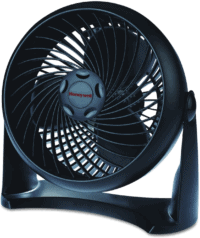
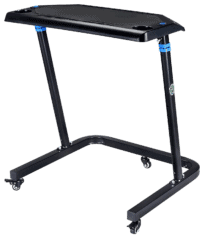
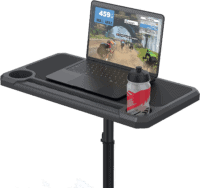

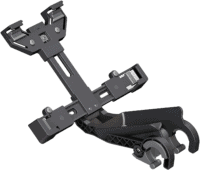













Forget about a cassette – does it come with a pack of Dorito’s? :-P
Is the steering accessory for the Nero smart rollers?
Do you find that knowing the stats are going online makes you try harder?
nice job BTW !!
Hi Ray.
maybe i’m missing something…but in my opinion direto has 2 big issue:
the first was the belt in the 2017 edition and the second was its responsivness in erg but even in zwift when incline changes are quick.
It seems to me that the second one was not addressed because the entire system is the same but with ‘bigger magnets’.
at this point the first victim of the suito will be the direto imo
My early 2017 Direto has been great… I think I got one of the first units through Clever Training pre-order. Anyway, its been rock solid and I’m glad they are continuing the line. Regarding cadence, I tracked down a Drivo wired cadence sensor and installed it on my Direto. It worked fine and definitely stabilized cadence output. I think it also helped ERG-mode reaction time (i.e. low resistance to high resistance jumps), but that might just be my perception. Its hard to tell from the photos if they removed the cadence sensor input on the Direto X. On my original Direto, it is right next to the power cord. The software should absolutely ‘just work’ out of the box, but there is another option if anyone cares.
FYI, you linked your TrainerRoad ride file and not the workout. Your TR profile is private so the link goes to a blank page. You might change the link to the workout: https://www.trainerroad.com/cycling/workouts/199459-dc-rainmaker-30×30-trainer-test However, i’m not sure if that will show for anyone who isn’t in your DCR TrainerRoad Team.
Hi
I had an old Genius that I didn’t like and switched to spinning, which wasn’t fun either. Now I want to try the direct-drive trainer. If you compare road-like feel between Suito and Directo X, which is best? Should that not be the most important thing, most of the time I will probably spend in Zwift.
Hey Ray,
Thanks for the review.
You wrote: “Though, that trainer lacks the power of the Direto X, and doesn’t include a power meter.” (for the Elite Suito) – maybe I got something wrong, but in your “hands-on” of the Suito you wrote that it has an internal power meter.
“The Elite Suito (like many trainers these days), doesn’t have a built-in power meter.” – Sorry, my fault! Next time I try to read carefully first…
need to add category for your comparison chart – pedaling dynamics. please.
I will be looking for a mid-high end trainer in a few months time. When can I expect your 2020 bike trainers buyers guide? Beginning of November again? Thanks
Thank you for this test.
For you it is the best trainer in this price?
Direto X is better that Suito?
if they have not changed the belt system…suito easy win. a lot of direto 2018 are still in the broken belt club even with the new kit. this is for me the most important difference between suito and direto.
max incline/wattage are not so important…
Which is quieter, the Direto X or the KICKR Core?
KICKR CORE.
I’m looking at a one of the Elites Direto II (£550-£600), Suito (£550-£600), (Zumo £450) or possibly a Core (£700, unless get a decent second hand one for around £525-£550). I’m stumped on which to get: price, noise and reliability more important that gradients etc as I’m not going to be hitting any limits soon!).
So is the noise difference significant between these?
In fact realised the Drivo is £600 too…. Ugh, too many choices, any view on noise of Drivo vs Kickr Core?
Thank you for the test!
What do you recommend:
– Elite Direto X
– Wahoo kickr core
– Tacx Flux 2
I just can’t decide, pls help me
I’d cross out Flux 2, and mainly aim between Core and Direto X. For me the road feel and all-around accuracy is better on Core especially in ERG mode, but of course, it costs more.
I went for the kickr core and it’s awesome.
Thank you for your recommendation!
Hey Ray,
whats more quiet Suito or DIreto X. Comparing to Kickr Core D or Suito?. I got a 13 month baby in a very small apartment and an his exhausted mom, so you know how important is sound :D
please help
Thanks!
Comparing to the Core, the Core/KICKR are quieter – easily. But realistically, I don’t think you’d notice if the baby is in another room.
I’d have to double-check some quick noise tests, but I’m pretty sure the Suito is quiter between Direto X and Suito.
Thank you!!!
Ordered
Hi ray,
I ve read lot of about elite suito manufacturing issues. Are there any news?
There are not many options around here so i am deciding between direto x and suito. Suito is my favourite it is about 550 euros (cassete not included) that is 100 euros cheaper than direto but i am worried about getting a broken unit. You wrote that is also quieter than direto.
Noise and reliability is my main goal. I would consider core too but it is bit pricey and i would only get it only from online store from another country. So if there are any issues i would have to send it back which is not cheap.
Which one do you recommend?
Suito 550e cassete not included
Direto x 660e
Both from LBS so easier for me if they got broken
And core around 800r from e-store
So possible additional cost in case of broken unit.
Thanks for advice
Hi there,
there was a lot writen about a pros and cons between Dreto and Suito … at the end which one would be right choice Direto X
is Direto X worth to spend extra money compare to Suito?
Considering the issues with the Suito, I’m not sure it’s much competition at the moment!
have not heard about issues pls can you share more details?
I ve read about some power accuracy and also some hardware issues.maybe there is more…
You wrote that there are diretto x and suito comparisions. Can you share please.
I curious if there is some noise comparision video?
Check out the comments in this post: link to dcrainmaker.com
Hi
In Trainer Comparisons: above it says that Direto X has Ability to update unit firmware. Can you tell how to do it, I can only find texts that there are no updates and myETraining app does not have that feature. Is it something I’ve missed? For it would be good with an update, I think Direto shows too much power, now I have connected the Garmin pedals to Zwift and it works better. But it would be better not to have to calibrate the pedals every time
It’s coming as part of the just released Upgrado app.
one year later: nope, nothing is coming. the upgrado app seems to be pretty pointless – I think they’ve released one upgraded firmware through it (for their whole product line)
Focus say you can’t mount a carbon frame bike on a trainer. Can I mount my Focus Izalco race with through axle to this trainer? I don’t want to spend upwards of £500 and not be able to use it.
Then I’d tell Focus to decide if they want to have customers in 2019 and beyond. Honestly.
We’re seeing a bit shift from bike companies in the last 6-8 months, largely fueled by Zwift and TrainerRoad, in actually putting in place policies to support warranties with trainer usage. I’d push back on Focus, and do so strongly.
The answer I got from Focus
Well, the good news there is that the Elite Direto isn’t a clamp-on trainer. It’s a skewer based trainer.
Made 3 wo with new direto X and compared with my Quarq PM.
Really satisfied
Direto X
Quarq
Direto X
newbie question :
don’t have internal power meter? i dont get it, what do you mean?
this and suito, what’s the main difference! thanks ! my dealer ask me to get this and return the suito. i hope this will not disappoint me.
Hi!
Richard from Sweden here. I have the “first” Direto since it came out and I’m very pleased with it. The sound could be lower though and that’s where the Direto X becomes interesting – along with the other new features…
My question is simple: do you think it’s worth the money upgrading to the new Direto X? I could always sell my present version…
BTW you are incredible in what you do here.
All the best!
/Richard Jensen
… incredible at… Sorry… :-)
Honestly no, if you already have a Direto, I wouldn’t upgrade. I think even Elite would say the same.
Today my Direto X wasn’t in perfect shape…maybe I wasn’t…
Could someone explain this results: w.o 10 x 1′ @ 380w:
10x 1′ @380w
What gearing were you in?
There are cases where trainers can’t sustain power at a given gearing – which is usually driven by speed (so really a combination of cadence + gearing).
Hi Ray, started with 36/16 and switched to 52/19-21 trying to reach the “target”.
So the 36/16 should have been ideal. However, based on what you’re saying and the variability – it almost looks like ERG mode wasn’t correctly engaged.
Which app?
I was training with a work out loaded on my Garmin 1030.
Hello. Sorry for the silly question. How do I measure exactly the wheel circumference to input? Shoulndt this simply be: 28″ * pi greek * 2.54 * 10 = 2234 mm?
I have been looking for a new smart trainer for quite a long time – actually I was almost decided to buy Tacx Flux S Smart, but finally I’ve ordered a Direto X just yesterday, because there was a very good offer at one of the webshops in the coutry where I live – the price was acout 640 euros. A colleague of mine has the 1st version of Direto (2017) and is very happy with it using Zwift.
However, as I read this review (especially about the ERG issues) I am not sure anymore, whether it was a right decision and I’m considering to send the trainer back straight directly after I’ll get it. Furthermore, I will only be able to use Zwift on iPad or iPhone, so I am limited to Bluetooth, and I’ve heard about issues in this matter too.
I have the possibility to send back the trainer within 30 days and get the full refund.
I just can’t stop thinking I should have ordered the Tacx Flux S :(
Should I get the Direto X or a Cycleops H2 for $40 more?
Here is my Polish review of this unit.
link to goultra.pl
Cheers
Jacek
assioma vs elite direto x, the trainer is pretty accurate !!
Hi. Brilliant videos and reviews! Do you feel the X is a big improvement in terms of gradient responsiveness in Zwift over the original Direto? Noticed your comments about how well the X dealt with Titans Grove – was that much better than the original Direto achieved? Finally – how is the responsiveness of the Suito in comparison with Direto and Direto X? Thanks!
No, pretty subtle. I wouldn’t upgrade a Direto to Direto X (and honestly, I think Elite would agree).
Thanks for this, I asked on your winter trainer review if Suito would have less lag that Direto or Direto X. Was thinking it might have different technology making it respond to gradients more quickly, Thanks again.
Thanks for this, would Suito have less lag?
Have just taken the plunge with the Elite Suito. Got it for £550 from Halfords with 10% more off with a British Cycling 10% Discount so just £495. Will update once have had chance to give it a try!
@Mr Alan Mayes – is that not the Direto 2 rather than Direto X you have bought for £550 with discount in Halfords?
It’s the Suito actually. Used first time today and pretty impressed. The chain is a bit noisy in top 2 gears but guess that could be new cassette with older chain and it seems to be bedding in as I ride more. Was a bit confused by the circumference setting but worked out in end needed to set to 2105 for my etraining app (700c x 25) tyre. Instructions said for Zwift probably don’t need to set if using the trainer in fc-e mode but may check that again.
As it is much more accurate that my old wheel on qubo one downside is that I am having to work harder for the same wkg!
My free 12 months code for my etraining did not work and messaged Elite about that.
Will post any further views on the Suito thread!
Thanks to DC Rainmaker as the advice and videos have been a huge help in making this choice!
I’ve a Dorito 2 and was surprised that I can’t get more than 10% gradients out of it. It’s because of my weight, cadence W/kg, etc, I’d need to do more than 15kph over 10%+ (!!) to get the declared gradients.
I’ve contacted Elite and got a spreadsheet with the trainer response curve. Very nice, but we could know this before committing to buying the trainer, and I’ve bought basically to train climbs.
Anyways, all that just to maybe suggest Ray it would be really nice if you had a way to get some sort of actual gradient comparison between trainers, as they assume different rider weight, bike weight, power/weight, whatever else, to get to the magic number.
Just about to jump on this smart trainer bandwagon – I’m looking for something to allow me to train when the weather in the UK is not letting me get out and on my local roads. Initially I was interested in the Tacx Flux S but after reading a number of articles, forums and watching videos I’m leaning towards an Elite unit, perhaps the Direto or a stretch to the Direto-X.
Some good deals on currently for the following units so wondering which would be the best buy out of them –
Tacx Flux S = £549 (inc discount £495)
Elite Direto = £550 (inc discount £495)
Elite Direto X = £675 (in discount £607)
and the wildcard – Elite Drivo = £499 (clearance from Halfords)
I understand the Drivo is the big daddy to the Direto so would this be the better buy out of all of them?
Also I intend to utilise both my road and mountain bike so need support for a long rear cage (which I believe all should cope with)
Thanks!
Thank You for a great review.
Great review.
I bought a Direto X over the holidays, and just started using it in the last week. I have to say i´m very disappointed in the road feel. My previous trainer was a first gen wahoo snap, and its road feel was much better. The direto X feels like i´m riding through wet sand or constantly climbing, if that makes sense. Or in anther way to describe it, like the brakes are always on. No momentum in the pedaling at all.
It also handles slope transitions very abruptly. Even with only a 1% slope change it feels like a brake being released. Almost like ride up a staircase where you go from slope to flat in an instant.
Has anyone else noticed this? I only use zwift in sim mode, and it´s not fun with this trainer.
Anyone have any experience with the Saris H3 in these regards?
Same feeling here. Are you riding previous activities recorded with a Garmin, Wahoo, Polar device?
However I’ve the solution.
What is your solution?
I was experiencing the same: following an activity recorded with Garmin 1030, even riding through a full flat course… legs were jammed by sudden climbs at 1-2%.
To avoid this extract the .gpx ride, upload it on link to openstreetmap.org then download again the file .gpx
If you use a Garmin device you’ve to convert it in .fit
Enjoy your rides ;)
I only use zwift sim mode through a Windows 10 pc
I’m having the exact same problem. Moved from a Wahoo Kick Snap Gen1 to the Direto X. I cannot hold power on flats sections in Zwift as my legs are spinning out.
I only use zwift in sim mode, and it´s not fun with this trainer.
Hi
anyone has tried to control diretoX with Golden Cheetah ?
On my PC I have an ant + key and with zwift or roovy the trainer is detected.
With GoldenCheetah impossible to detect the trainer? Do you have an idea ?
Thks
Hey,
Couple of deals right now in UK. After your opinion:
Direto X for £500 ($650)
Direto 2 for £472 ($612)
Are they pretty much a toss up for that price difference?
Thanks
Yeah, about as much of a wash as you can get to be honest. I think the accuracy claim difference is probably identical in both, however the sound is noticeable. So there’s that. Not much, but a tiny bit. I don’t think the 14-18% simulation difference will be noticed by many, since 14% sucks more than enough as it is (if people actually set Zwift to 100% simulation difference).
Thanks!
Which one was louder? No I don’t think I’ll care about not being able to get to 18% – like I don’t care that I won’t be able to get out 2500W!
But in your opinion, it’s worth purchasing either, and cassette, rather than spending more on a Suito. Don’t ask me why the Suito is now more expensive than the Direto…
The older Direto is slightly louder.
While I like the Suito better than the Direto series in theory (more practical), I think the Direto is a bit of a known quantity related to manufacturing these days. It seems like 99% of people are perfectly fine with their Suito, but it also seems like 99.9% of people are perfectly fine with a Direto. So if you can pickup one and save some money compared to Suito (all-in), then I’d probably go that route.
Appreciate your input. Hopefully pick one up soon.
Thanks
Quick question pls. Just bought it, set it up and plugged it in. When pedaling power off no problem. With power applied then it’s about 800 watts resistance. Can I fix this? Emailed Elite but spent “we’ll get back to you in three days” and they’re in Italy which is having virus lockdown.is it done? Bought at clevertraining so maybe return it?
Ray,
Great website. I have found it super helpful and straight forward. THANKS for all your hard work.
Ok, I am really new to bike trainers. I have a hybrid with a 8 cassette which fit well with the two spacers provided on the Direto X. Look, I just want to be able to control the resistance or to increase it over the baseline at this point. Or do simple workout routines without paying a monthly fee at this point. Are there simple controllers/computer that can hook up to the Direto X? Any ideas?
Thanks for your help.
Did you have any experience with elite padaling analysis feature? (which requires additional payment…)
I’m considering to buy a direto X ,which is currently about 170usd cheaper than kiker core in korea
I’m curious weather the pedaly analysis feature is actually useful, but I couldn’t find practical info..
I’ve browsed your site, but i couldn’t see any review about that feature.
On other websites, I could only find advertisements, not real reviews…
I’d presume that it will be less useful than a garmin vector, but i have to stick with a speedplay
Hi,
I have a problem of cassette. I have a Ultegra 10 speed cassette on my wheel but for the trainer I decide to install a 10 speed 105 cassette for cost reason.
The problem is the ring on the freehub. I initially installed one Ring but there are some loose , then I install 2 rings , but I still have a little bit of loose. Then I decide to install a third ring which is perfect , no loose in the cassette. But now the shifting on the trainer is a little bit off. But on my wheel it it perfect.
Then I remove the third ring, the shifting on the trainer is better but not as good as on my wheel.
My question is it normal to have that loose on the cassette with 2 ring and to have that t poor shifting performance on the trainer compare to my wheel.
Also is it ok to train with that loose in the casette ??
Thanks for help.
Hey DC, you mentioned here that “Elite says that they’re going to dig into the firmware” to address the ERG issues. Curious if you’ve received any updates from Elite on this and/or whether this remains an issue?
I share my bad experience with Clever Training. I made a reservation about 2 months ago and received the following email two days ago.
Hi,
In the first part of you review, you said it came with a thru axel adapter. Does it come with the quick release one as well? I don’t see it in the picture
Thanks
Yup, it does. You can see it in a number of the unboxing pictures, starting inside the plastic bag.
Good Afternoon Ray,
2017 Elite Direto owner. My ERG mode reaction time is 6-8 seconds on large (150 and more watts) jumps. Tried both small and large front chainrings with the same responsiveness. This makes intervals 50 seconds and under difficult to the point of me not scheduling them. Love almost all the other aspects of the Elite. Any fixes, solutions or recommendations to lower the response time to 3-5 seconds.
Thanks, Matt
Hi, one of the inprovement of Directo XR vs Direto X is the fast response in ERG mode.
A few years ago ELITE said they was evaluating the possibility to estend this improvement on old version (Direto and Direto X) relesing a new firmware version.
Do you have any feedback about this new firmware version?
Thankd.